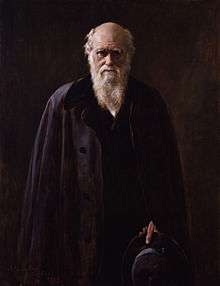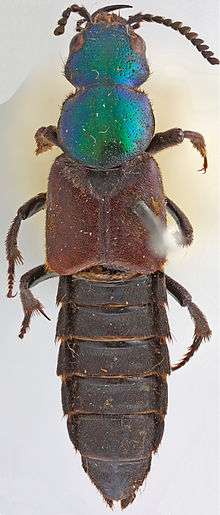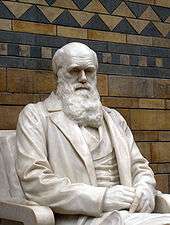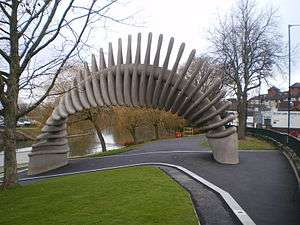Commemoration of Charles Darwin
Commemoration of Charles Darwin began with geographical features named after Darwin while he was still on the Beagle survey voyage, continued after his return with the naming of species he had collected, and extended further with his increasing fame. Many geographical features, species and institutions bear his name. Interest in his work has led to scholarship and publications, nicknamed the Darwin Industry, and his life is remembered in fiction, film and TV productions as well as in numerous biographies. Darwin Day has become an annual event, and in 2009 there were worldwide celebrations to mark the bicentenary of Darwin's birth and the 150th anniversary of the publication of On the Origin of Species.

Geographical features
During Darwin's lifetime, many geographical features were given his name. An expanse of water adjoining the Beagle Channel was named Darwin Sound by HMS Beagle captain Robert FitzRoy after Darwin's prompt action, along with two or three of the men, saved them from being marooned on a nearby shore when a collapsing glacier caused a large wave that would have swept away their boats,[1] and the nearby Mount Darwin in the Andes was named in celebration of Darwin's 25th birthday.[2] Another Darwin Sound in British Columbia's Queen Charlotte Islands, between Moresby Island and Lyell Island, was named in 1878 by Canada's then-chief geographer George M. Dawson for Darwin.[3] When the Beagle was surveying Australia in 1839, Darwin's friend John Lort Stokes sighted a natural harbour which the ship's captain Wickham named Port Darwin.[4] The settlement of Palmerston founded there in 1869 was officially renamed Darwin in 1911. It became the capital city of Australia's Northern Territory.[4]
Scientific names

More than 300 species, nine genera, and some higher taxa have been named after Darwin.[5][6][7] In 1837, the ornithologist John Gould named a specimen Darwin had collected in Patagonia Rhea darwinii,[8] it is now known as Darwin's rhea (Rhea pennata). Similarly, Darwin's frog, Rhinoderma darwinii, was so named because Darwin discovered the species in Chile, and the family Rhinodermatidae are commonly known as Darwin's frogs.
In 2009, a remarkably complete fossil primate from 47 million years ago was announced as a significant transitional fossil, and named Darwinius to celebrate Darwin's bicentenary.[9]
Although related to American Emberizidae or tanagers rather than finches, the group of species related to those Darwin found in the Galápagos Islands became popularly known as "Darwin's finches" following publication of David Lack's book of that name in 1947, fostering inaccurate legends about their significance to his work.[10]
Genera include:
- Darwinilus, a genus of staphylinid beetles
- Darwiniothamnus, a genus of flowering plant
- Darwinius, a genus of Eocene primates
- Darwinopterus, a genus of long-tailed pterosaurs from China
- Darwinula, an ostracod genus in the eponymous suborder Darwinulocopina, superfamily Darwinuloidea, family Darwinulidae.
Species Over 300 species are named darwinii, darwini, or charlesdarwini. Examples include:
- Caerostris darwini, Darwin's bark spider, an orb-weaver spider discovered in Madagascar
- Demandasaurus darwini, a rebbachisaurid sauropod dinosaur from Spain.[11]
- Ingerana charlesdarwini, an endangered frog of Southeast Asia
Institutions

Darwin in Australia features Charles Darwin University[12] and Charles Darwin National Park.[13] However, Darwin College, Cambridge, founded in 1964, was named in honour of the Darwin family, in part because they owned some of the site.[14]
The Linnean Society of London has commemorated Darwin's achievements by the award of the Darwin-Wallace Medal since 1908.
In the Galápagos Islands, the Charles Darwin Foundation based at the Charles Darwin Research Station does research and conservation. To mark 2009 they are helping to reintroduce to Floreana Island (Charles Island) the specific mockingbird which first alerted Darwin to species being unique to islands. It was eradicated from the main island by European species, mainly rats and goats, but survived on two small islands nearby.[15]
Darwin came fourth in the 100 Greatest Britons poll sponsored by the BBC and voted for by the public.[16][17] In 2000 Darwin's image appeared on the Bank of England ten pound note, replacing Charles Dickens. His impressive, luxuriant beard (which was reportedly difficult to forge) was said to be a contributory factor to the bank's choice.[18]
As a humorous celebration of evolution, the annual Darwin Award is bestowed on individuals who "improve our gene pool by removing themselves from it."[19]
Darwin day, and 2009 commemorations
Darwin Day has become an annual celebration, and in 2009 the bicentenary of Darwin's birth and the 150th anniversary of the publication of On the Origin of Species were celebrated by events and publications around the world.[20] The Darwin exhibition, after opening at the American Museum of Natural History in New York City in 2006, was shown at the Museum of Science, Boston, the Field Museum in Chicago, the Royal Ontario Museum in Toronto,[21] then from 14 November 2008 to 19 April 2009 in the Natural History Museum, London, as part of the Darwin200 programme of events across the United Kingdom.[22] It also appears at the Palazzo delle Esposizioni in Rome from 12 February to 3 May 2009.[23] The University of Cambridge featured a festival in July 2009.[24] His birthplace, Shrewsbury, celebrated with "Darwin's Shrewsbury 2009 Festival" events during the year.[25] An abstract sculpture, The Quantum Leap, was erected for the celebrations, and unveiled on 8 October 2009 by Randal Keynes, a great-great-grandson of Darwin. A 'geological garden' was created on its site to mark the interest which Darwin had in the field during his childhood.[26]

In the United Kingdom a special commemorative issue of the two pound coin shows a portrait of Darwin facing a chimpanzee surrounded by the inscription 1809 DARWIN 2009, with the edge inscription ON THE ORIGIN OF SPECIES 1859. Collector versions of the coin have been released at a premium, and during the year the coins will be available from banks and post offices at face value.[27] To celebrate Darwin's life and achievements, the BBC has commissioned numerous television and radio programmes known collectively as the BBC Darwin Season.
In September 2008, the Church of England issued an article saying that the 200th anniversary of his birth was a fitting time to apologise to Darwin "for misunderstanding you and, by getting our first reaction wrong, encouraging others to misunderstand you still".[28]
Since 2004, Universidad Francisco Marroquín (UFM) in Guatemala, has celebrated Darwin Day with a series of conferences that includes international speakers. To watch the UFM's Darwin Day video collection click here.[29]
On 22 January 2013, a resolution was introduced to the United States Congress designating 12 February 2013 (Charles Darwin's 204th birthday) as "Darwin Day" to recognise "the importance of sciences in the betterment of humanity".[30]
Darwin's alma mater, Christ's College, commemorated the bicentenary with the unveiling of a life-sized bronze statue of the young Darwin (aged 22).[31] The statue was created by Anthony Smith and unveiled by Prince Philip on 12 February 2009. It now forms the centrepiece of the college's Darwin Garden.[32]
Books, films and series
Numerous biographies of Darwin have been written, and the 1980 biographical novel The Origin by Irving Stone gives a closely researched fictional account of Darwin's life from the age of 22 onwards.
A dramatic motion picture entitled Creation was released in 2009, joining a short list of film dramas about Darwin, including The Darwin Adventure, released in 1972.
He appears in the webseries Super Science Friends.
References
- FitzRoy 1839, pp. 216–8
- Leff 2000, Darwin's Timeline
- "Darwin Sound". BC Geographical Names.
- "Territory origins". Northern Territory Department of Planning and Infrastructure, Australia. Archived from the original on 18 September 2006. Retrieved 15 December 2006.
- "Charles Darwin 200 years – Things you didn't know about Charles Darwin". Retrieved 23 May 2009.
- Jozwiak, Piotr; Rewicz, Tomasz; Pabis, Krzysztof (2015). "Taxonomic etymology – in search of inspiration". ZooKeys. 513: 143–160. doi:10.3897/zookeys.513.9873. PMC 4524282. PMID 26257573.
- Miličić, D.; Lučić, L.; Pavković-Lučić, S. (2011). "How Many Darwins? – List Of Animal Taxa Named After Charles Darwin" (PDF). Natura Montenegrina. 10 (4): 515–532. Archived from the original (PDF) on 24 July 2015.
- "Darwin, C. R. (Read 14 March 1837) Notes on Rhea americana and Rhea darwinii, Proceedings of the Zoological Society of London". Retrieved 17 December 2008.
- Christine McGourty (19 May 2009). "Science & Environment; Scientists hail stunning fossil". BBC News. Retrieved 20 May 2009.
- Sulloway 1982, pp. 45–47
- Fidel Torcida Fernández-Baldor; José Ignacio Canudo; Pedro Huerta; Diego Montero; Xabier Pereda Suberbiola; Leonardo Salgado (2011). "Demandasaurus darwini, a new rebbachisaurid sauropod from the Early Cretaceous of the Iberian Peninsula". Acta Palaeontologica Polonica. 56: 535–552. doi:10.4202/app.2010.0003.
- "Charles Darwin University Homepage". Retrieved 15 December 2006.
- Charles Darwin National Park. Archived 18 January 2008 at the Wayback Machine Northern Territory, Australia Government. Retrieved on 15 December 2006.
- Darwin College:About Darwin. Archived 28 October 2009 at the Wayback Machine Darwin College, Cambridge University website. Retrieved on 10 December 2006.
- Lewis Smith (3 January 2009). "Mockingbird goes back to its origins in honour of Charles Darwin – Times Online". The Times. London. Retrieved 13 February 2009.
- Ten greatest Britons chosen, BBC News, 20 October 2002, retrieved 18 August 2009
- What’s on? BBC Great Britons. National Portrait Gallery. Retrieved on 15 December 2006.
- "How to join the noteworthy." BBC News (7 November 2000). Retrieved on 15 December 2006.
- Darwin Awards. DarwinAwards.com. Retrieved on 11 December 2007.
- Shapin, Steven (7 January 2010), The Darwin Show, London Review of Books, retrieved 25 January 2010
- "Darwin | American Museum of Natural History". Meet the curator. Archived from the original on 1 December 2008. Retrieved 28 November 2008.
- "Darwin 200: Celebrating Charles Darwin's bicentenary". Natural History Museum. Archived from the original on 3 December 2008. Retrieved 23 November 2008.
- "Palazzo delle Esposizioni". Darwin 1809 – 2009, A cura di Niles Eldredge, Ian Tattersall e Telmo Pievani. Archived from the original on 17 February 2009. Retrieved 22 February 2009.
- "Darwin 2009 – The Festival". University of Cambridge. Archived from the original on 4 December 2008. Retrieved 23 November 2008.
- "Darwin's Shrewsbury 2009 Festival, Birthplace, History and Information". Retrieved 16 December 2008.
- "Shrewsbury's Quantum Leap built". BBC News. 22 June 2009.
- "House of Commons Hansard Ministerial Statements for 12 July 2007". Retrieved 23 November 2008.
- Good religion needs good science Archived 21 January 2009 at the Wayback Machine Rev Dr Malcolm Brown, Director of Mission and Public Affairs, Church of England. Retrieved 17 September 2008.
- http://www.newmedia.ufm.edu/gsm/index.php?title=Darwin_Day
- Oppenheimer, Mark (1 February 2013). "Seeing Darwin Through Christian Eyes? It All Depends on the Christian". The New York Times. Retrieved 2 February 2013.
- "Sculptor challenges Darwin image". BBC News. Retrieved 30 October 2016.
- "Darwin Statue". Christ's College, Cambridge. Archived from the original on 31 October 2016. Retrieved 30 October 2016.
External links
| Wikimedia Commons has media related to Things named after Charles Darwin. |
- The Complete Works of Charles Darwin Online – Darwin Online; Darwin's publications, private papers and bibliography, supplementary works including biographies, obituaries and reviews.
- Darwin Correspondence Project Full text and notes for complete correspondence to 1867, with summaries of all the rest
- Darwin 200: Celebrating Charles Darwin's bicentenary, Natural History Museum
- Listing of the significant places in Shrewsbury relevant to Darwin’s early life.
- The life and times of Charles Darwin, an audio slideshow, The Guardian, Thursday 12 February 2009, (3 min 20 sec).
- CBC Digital Archives: Charles Darwin and the Origins of Evolution
- Darwin's Volcano – a short video discussing Darwin and Agassiz' coral reef formation debate
- Darwin's Brave New World – A 3-part drama-documentary exploring Charles Darwin and the significant contributions of his colleagues Joseph Hooker, Thomas Huxley and Alfred Russel Wallace also featuring interviews with Richard Dawkins, David Suzuki, Jared Diamond and Iain McCalman.
- A naturalists voyage around the world Account of the Beagle voyage using animation, in English from Centre national de la recherche scientifique, Paris.